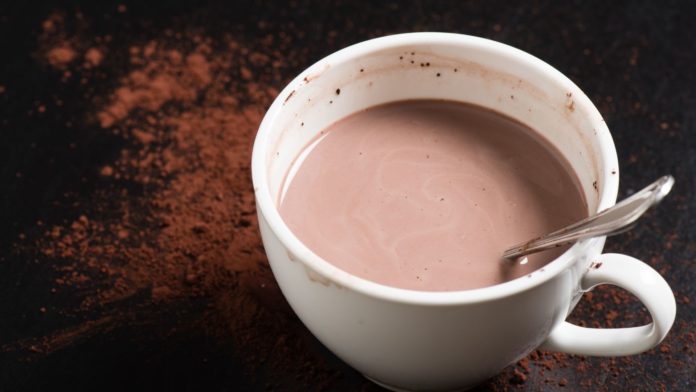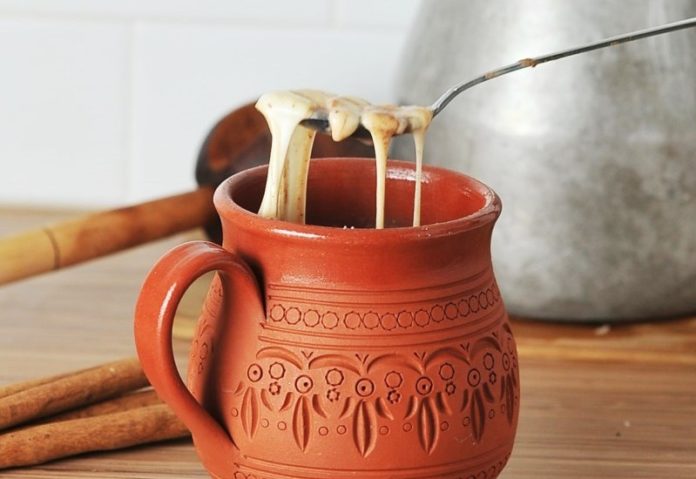You don’t need a Latin abuelita (a mom, tía, or friend will suffice) trying to feed you all day to know that Latin cooking is full of tips, tricks, and hacks that make life tastier, zestier, and all around funkier. Latin cooks know their way around some exotic ingredients, are resourceful, and are quick and savvy about prep work and storage. So many gatherings and events for Latin families are punctuated by the food we eat that even a quick glance across our cultures reveals a rich catalog of potentially life-altering food hacks.
Cacao Mastery
Sold in thick, heavy bars tightly wrapped in plastic, Colombian hot chocolate is prepared by placing as many tablets of the bitter, often presweetened chocolate in an aluminum chocolate and heated with milk or water on the stovetop. As the liquid warms, the mixture is beaten with a molinillo, which encourages the chocolate to dissolve. As the common lore tells it , the chocolate must be brought up to a boil three times before serving for painless digestion.
Growing up, this drink was the absolute best after-school snack… because it’s only one piece of the puzzle. Called chocolate santafereño, an allusion to Bogotá old name “Santa Fé de Bogotá,” the thick, sweet chocolate is an antidote to those cold afternoons and the best vehicle to slowly soften a delicious surprise at the bottom – WAIT FOR IT: little cubes of queso campesino, a semi-soft farmer’s cheese, melted to the point of chewy, pizza-cheese-like stretch. Can I please get an amen on this? I personally recommend block mozzarella as a substitute (not fresh or shredded). You’ll never know how badly you’ll needed cheese in your hot chocolate.
Recipe here.
Avo Everything & Guacanda Forever
From Mexico, where we get the word for the fruit itself (fun fact: aguacate is Nahuatl for testicle), all the way down to Chile and Argentina where it’s called palta, most Latin cooks will learn their way around an avocado. With so many different varieties of avocados available in the U.S., signs of ripeness vary across types. But one thing that carries across uniformly from the small, creamy, blackish Haas to the larger, more watery Florida avocado, are the techniques for getting an even dice or a clean slice.
The first step is to slice the fruit in half around the pit; then, you take the pit out by very carefully tapping the blade of the knife into the pit until it sticks, then pull the knife out along with the pit. Then you are free to cut as precisely as you wish into each half, the thick peel acting as a guard for your hand or you can scoop out the flesh with a spoon first and cut down on your board.
On the other hand, if you’re making guacamole, a spoon alone will suffice to scoop out the buttery flesh into a bowl or molcajete if you’re opting for a more legit approach. Recipes shown variances across households, regions, and restaurants, for instance garlic versus chopped onion or the inclusion of cumin (personally: please, no); but one thing that is universal is the struggle to keep the Yoda-like green of the fruit from oxidizing and turning an unappetizing brown. Check out some foolproof ways to keep that guac green here.
The Ever-Divisive Cilantro
Evidently, those who dislike cilantro (the objection is usually that the herb tastes like soap to them) are genetically predisposed. That’s really a shame, because cilantro enhances so many Latin dishes, from the seafood ceviches and stews of Perú to the many salsa frescas of Central America. It also figures prominently in sofritos from the Caribbean down into the continent and flavors the Colombia hangover cure, changua, a breakfast soup made from milk, green onions, cilantro, and bread. Best way to keep your cilantro fresh and perky — treat it like a flower:
Here are some tips on how to store cilantro.
Mango Maneuvering
If you didn’t grow up eating mangoes with your hands, tearing the tough peel with your teeth and having no choice but to let the juices run down your face, knees, legs, down the stoop, you might not know about the big, hard pit in the center or the tough fibers you have to cut through (or pull out of your teeth with your fingers if you went for it kid-style). It turns out, anticipating the pit is all you need to do to be able to slice or dice a mango of any size. Depending on whether or not your peeler can tackle the thick skin of a mango, you can either cut your desired slices into each half first — hedgehog style — or peel the fruit and then halve it. Either way, you will have the cubes or slices you need for that salad or to toss with some lime juice, salt, and chili.
A Reason for the Season
Is your sofrito missing something? Having a hard time replicating your abuela’s sazón without resorting to the magic cube that turns everything yellow? Or you want those same good results but without the chemicals? Just like every Desi cook mixes a different blend of masala for their chai, adobo is a generic word meaning “some sort of seasoning blend.”
In our mother’s and grandmother’s times, every cook’s sazón was recognizably different because everyone’s spice mix was unique. By mixing your own, not only do you skip the nasty ingredients, but you can customize your adobo to your personal tastes — a little less oregano, a little more garlic. See a basic recipe here and raid your own spice rack to get cooking.
Yerba Mate, the Caffeine of all Caffeines
While it’s take some of us until a year or two ago to discover the health benefits of green tea, the Argentinians have known it all along. Sipping their yerba mate, a type of green tea, all day keeps them energized and allegedly clear-minded.
Replacing coffee almost completely within the culture, mate is ubiquitous and rich in minerals and vitamins, in addition to caffeine. Since it’s sipped through a straw straight from its namesake gourd, usually without sweetener, it is simpler, cheaper, and much lower in calories than a latte.
Java the Hottest
In the caffeinated beverage section, most Latin countries favor coffee over tea, and many boast some of the world’s best roasts, grinds, and preparations. Brazilian, Colombian, and Costa Rican coffee are all delicious and usually prepared through some sort of drip method — pour over, percolator, or if you’re super old school on the stovetop, coffee grounds held together by a length of cheesecloth or an unused stocking. Coffee is served in Latin America with milk for breakfast and then black and sweetened after lunch or in the mid-afternoon.
The most powerful, though, of the Latin preparations, is Cuban coffee. Prepared con leche for breakfast, all you need is a block of Bustelo, some sugar, and a stovetop espresso maker, and you can have a cortadito, the equivalent of an espresso macchiato or an espresso with a touch of milk, after lunch. The most social iteration of the great and powerful Cuban coffee though is the colada: dark, thick, and sweet, you will get a small cup of it and six or eight thimble-sized cups at the walk-up coffee window. The colada is designed to be shared with as many people, because though it be little, it is mighty strong. See what happens when you don’t anticipate the power of the colada here.
Put on an Egg on It
The “put an egg on it” movement that enhances grain and vegetable dishes by the simple stroke of adding even a single photogenic yolk must have taken a page from the Latin principle that anything from pastry to a slice of white cheese is instantly elevated by the addition of guava paste.
Called bocadillo in Colombia and guayaba almost everywhere else, guava paste is a popular filling for Cuban pastelitos (turnovers) and Puerto Rican empanadas. It is also used to fill and flavor cakes, cookies and even ice cream, often times in combination with a salty or creamy white cheese for contrast.
We are the Taco Motherboard
The taco has become an incredibly popular food in recent years. Harnessing the portability of a sandwich together with the excitement of combining cooked and raw fillings have helped this simple street food achieve legendary status, from food trucks to linen tablecloth restaurants around the country.
[advanced_iframe src=”<iframe src=”https://giphy.com/embed/sHpGMa83uvngY” width=”480″ height=”318″ frameBorder=”0″ class=”giphy-embed” allowFullScreen></iframe><p><a href=”https://giphy.com/gifs/food-gif-taco-sHpGMa83uvngY”>via GIPHY</a></p>” width=”100%” height=”600″]
My favorites always include a cooked protein together with a raw slaw of some sort and avocado, always avocado. You can check out over 50 more recipes here, but the magic of tacos is that any recipe is only a guide…the combinations are as infinite as your imagination.
Main Grain
There is nothing like a fresh tortilla. But unless you grew up practicing the art or you own a tortilla press, getting that freshness at home might seem beyond your capabilities. Fortunately,
[advanced_iframe src=”<iframe width=”560″ height=”315″ src=”https://www.youtube.com/embed/HzKuWBDDLPg” frameborder=”0″ allow=”accelerometer; autoplay; encrypted-media; gyroscope; picture-in-picture” allowfullscreen></iframe>” width=”100%” height=”600″]
Latin cooking is rarely gadget dependent, and there is a homegrown way to get a good tortilla assembly going, using only plastic wrap and a pan.
Legume Nation & Rice = Life Force
There is hardly a Latin meal that would not benefit from the addition of beans. Whether you’re looking to include refried beans in your quesadilla or you want to make some black bean soup, soaking your beans will always cut down on cooking time and get you to your goal bean quicker. Additionally, the use of slow cookers and instapots, have made bean cookery even more convenient, reducing the need to pre-plan and soak. Still, it’s nice to know that you don’t need more than a bowl of water and a nice heavy pot to make a perfect batch of beans. And if all else fails, you can always used canned, but don’t forget to rinse them first to get rid of the excess salt, the preservatives, and the tinny taste some of them carry.
[advanced_iframe src=”<iframe src=”https://giphy.com/embed/2wSC5iuEH0mSEjhOk8″ width=”480″ height=”270″ frameBorder=”0″ class=”giphy-embed” allowFullScreen></iframe><p><a href=”https://giphy.com/gifs/itssuppertime-viceland-its-suppertime-2wSC5iuEH0mSEjhOk8″>via GIPHY</a></p>” width=”100%” height=”600″]
Nothing goes better with a pot of beans than a pot of steaming, fluffy white rice. Rice is a staple across continents, and in no way unique to Latin America. But now that globalization has brought us awareness of cultural gems like the Persian dish tahdig — a flavorful pilaf covered by a shell of crunchy goodness that forms organically — we can all confess we’ve been fighting over la pega with our siblings in the kitchen for years. Also called pegao, cucayo, colón, and concolón, you can follow a recipe for it (Dominican, Puerto Rican, Cuban, Colombian, or Ecuadorian) or you can just make your rice in an Imusa-brand cauldron, designed to give you pega everytime. The difficult part is fighting over the crunchy goodness.
Keeping it Sassy with Beer-Cocktail Hybrids
Did someone just serve you a crappy beer? Feeling like you have no choice but to chug it or let it grow warm in the corner? Ask if you can mix them a michelada instead. Assemble as many of the ingredients you might throw in a bloody mary — lime, tomato juice, orange juice, pepper, worcestershire sauce, hot sauce, salt, all of the above — and gently mix, add ice, topping it with the beer. Give the glass a margarita rim, if you’re feeling fancy. Salud!
All Lime Everything
The power of lime cannot be overstated. Limón in our countries where the big yellow ones are not readily available but the juice and sour green Persian limes are ubiquitous, this juice is the liquid gold of the fruit bounty of Latin America.
From the main ingredient in your Thursday margarita to the force that cooks fish in a ceviche without the use of fire, lime juice takes the flavor of a fried empanada, a fried plantain or tostón, or any of the seafood dishes of Chile and Perú to the next level. Even sprinkled on other fruit like papaya, lime juice enhances the flavors of all of the other ingredients of a dish or its inherent sweetness. A popular street snack in Central and South America are slices of underripe mango tossed with lime, salt, and sometimes chili
For Image credit or remove please email for immediate removal - info@belatina.com







































